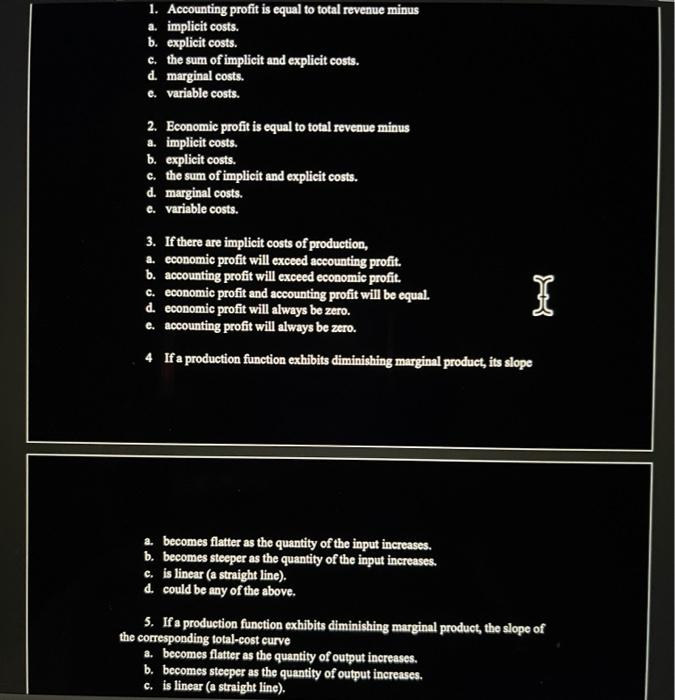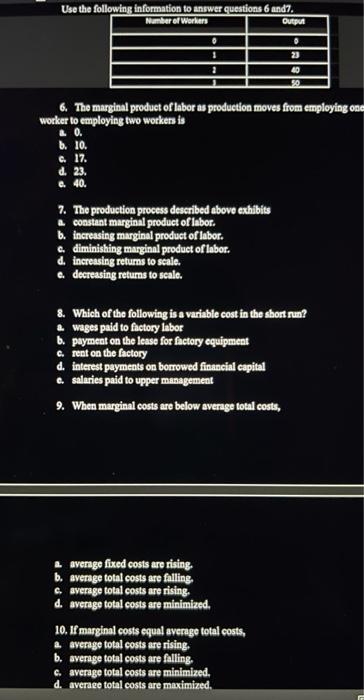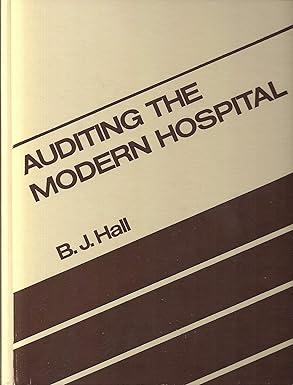Answered step by step
Verified Expert Solution
Question
1 Approved Answer
just i need the answer a or b or c or d 1. Accounting profit is equal to total revenue minus a. implicit costs. b.
just i need the answer a or b or c or d 


1. Accounting profit is equal to total revenue minus a. implicit costs. b. explicit costs. c. the sum of implicit and explicit costs. d. marginal costs. e. variable costs. 2. Economic profit is equal to total revenue minus a. implicit costs. b. explicit costs. C. the sum of implicit and explicit costs. d. marginal costs. c. variable costs. 3. If there are implicit costs of production, a. economic profit will exceed accounting profit. b. accounting profit will exceed economic profit. c. economic profit and accounting profit will be equal. d. economic profit will always be zero. e. accounting profit will always be zero. 4 If a production function exhibits diminishing marginal product, its slope a. becomes flatter as the quantity of the input increases. b. becomes steeper as the quantity of the input increases. c. is linear (a straight line). d could be any of the above. 5. If a production function exhibits diminishing marginal product, the slope of the corresponding total-cost curve a. becomes flatter as the quantity of output increases. b. becomes steeper as the quantity of output increases. c. is linear (a straight line). Use the following information to answer questions 6 and Number of Workers Output 1 40 50 6. The marginal product of labor as production moves from employing one worker to employing two workers is 10. b. 10. c. 17. d. 23. 40. 7. The production process described above exhibits a constant marginal product of labor. b. increasing marginal product of labor. c. diminishing marginal product of labor. d. increasing returns to scale. c. decreasing returns to scale. 8. Which of the following is a variable cost in the short run? & wages paid to factory labor b. payment on the lease for factory equipment c. rent on the factory d. interest payments on borrowed financial capital e salaries paid to upper management 9. When marginal costs are below average total costs, & average fixed costs are rising. b. average total costs are falling c. average total costs are rising. d. average total costs are minimized. 10. If marginal costs equal average total costs, a average total costs are rising. b. average total costs are falling, average total costs are minimized. d. average total costs are maximized. 11. If, as the quantity produced increases, a production function first exhibits increasing marginal product and later diminishing marginal product, the corresponding marginal-cost curve will a. slope upward. b. be U-shaped. c. slope downward. d. be flat (horizontal). 12. In the long run, if a very small factory were to expand its scale of operations, it is likely that it would initially experience a. economies of scale. b. constant returns to scale. c. diseconomies of scale. d. an increase in average total costs 


Step by Step Solution
There are 3 Steps involved in it
Step: 1

Get Instant Access to Expert-Tailored Solutions
See step-by-step solutions with expert insights and AI powered tools for academic success
Step: 2

Step: 3

Ace Your Homework with AI
Get the answers you need in no time with our AI-driven, step-by-step assistance
Get Started


